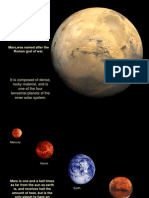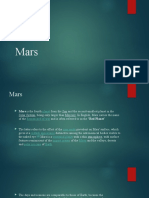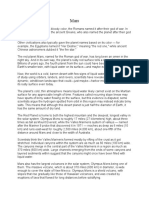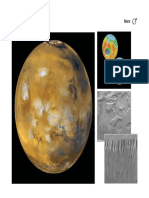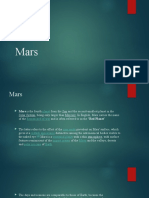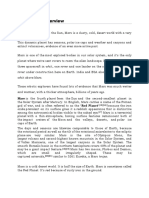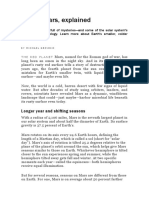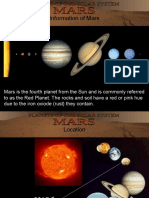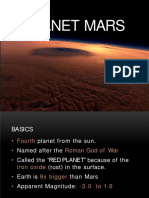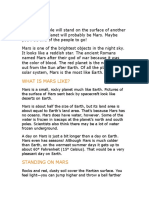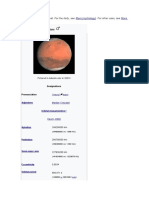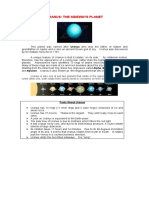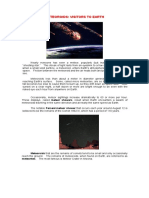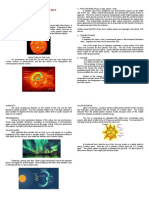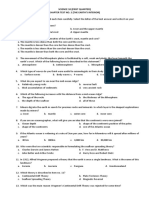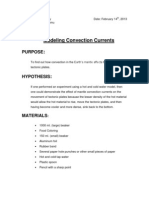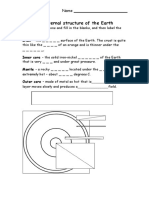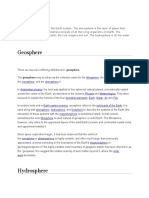MARS: THE RED PLANET
Mars, named for the Roman god of war, is often called the 'Red Planet' because it
appears in the sky as an orange-red star. The color caused the ancient Greeks and
Romans to name it after their god of war. Today, we know that the planet's appearance is
due to rust in the Martian rocks. Mars appears as a reddish ball interrupted by some
permanent dark regions that change intensity during the Martian year. The most
prominent telescopic features of Mars are its brilliant white polar caps, resembling
Earth’s.
The Martian atmosphere has only 1% the density of Earth’s, and it is primarily
carbon dioxide with tiny amounts of water vapor. The polar caps of Mars are made of
water ice, covered by a thin layer of frozen carbon dioxide. As winter nears in either
hemisphere, we see the equatorward growth of that hemisphere’s ice cap as
temperatures drop to -125 degrees Celsius and additional carbon dioxide is deposited.
Although the atmosphere of Mars is very thin, extensive dust storms occur and
may cause the color changes observed from Earth-based telescopes. Hurricane-force
winds up to 270 km per hour. Martian landscape is remarkably similar to a rocky desert
on Earth with abundant dunes and impact craters partially filled with dust.
Mariner 9, the first spacecraft to orbit another planet, reached Mars in 1971 amid
a raging dust storm. When the dust cleared, images of Mars’ northern hemisphere
revealed numerous large volcanoes.
The biggest volcano, Olympus Mons, is the size of Ohio and 23 km tall, nearly
three times higher than Mt. Everest. This gigantic volcano was last active about 100
million years ago.
Liquid water does not appear to exist anywhere on the martian surface.
However, poleward of about 30 degrees latitude ice can be found within a meter of the
surface and in the polar regions, it forms small permanent ice caps. In addition,
considerable evidence indicates that in the first billion years of the planet’s history, liquid
water flowed on the surface creating valleys and related features.
In particular, some areas of Mars exhibit treelike drainage patterns similar to those
created by streams on Earth. When these streamlike channels were first discovered,
some observers speculated that a thick, water-rich atmosphere capable of generating
torrential downpours once existed on Mars. The most likely source of water for these
flood valleys is the melting of subsurface ice.
Mars is the site of Olympus Mons, the largest volcano and second-highest
known mountain in the Solar System, and of Valles Marineris, one of the largest
canyons in the Solar System. The smooth Borealis basin in the northern hemisphere
covers 40% of the planet and may be a giant impact feature.
Mars has two moons, Phobos and Deimos, which are small and irregularly
shaped. It is likely that these moons are asteroids captured by gravity of Mars.
� Facts about Mars
On Mars, gravity is 62% lower than on Earth.
Mars has the largest, most intense and most powerful sandstorms of the Solar
System. They last for several months.
A day on Mars lasts 24 hours 39 minutes 35 seconds. A year on Mars takes
about 687 Earth-days.
Mars has the deepest canyon of the Solar System. Valles Marineris has 4
km in length and regions with 7 km in depth. This indicates that Mars used to
have large rivers.
Mars has the largest volcano of the Solar System. Olympus Mons is a
volcano with a height of 27 km.
Two moons of Mars are Phobos and Deimos. Phobos is expected to crash
into Mars because it moves very close to its atmosphere. It is expected to
occur over a period of 10 to 50 million years.
Right now, there are 7 robots roaming the plains of Mars: Viking 1, Viking 2,
Phoenix, Opportunity, Pathfinder, Curiosity and Spirit.
